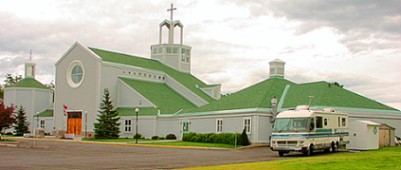St Etheldreda (whose optional memorial may be kept on June 23rd in England) helped establish religious life as an acceptable vocation for ex-queens and princesses.
Etheldreda (636-679), otherwise known as Aethelthryth or Audrey, became the most popular of all the Anglo-Saxon women saints.
She was the daughter of Anna, King of the East Angles, described by the Venerable Bede as “a very devout man, noble in mind and deed”. Evidently his example was not lost on his five children, four daughters and one son, every one of whom was recognised as a saint.
Indeed, the sisters helped to establish the religious life as an acceptable vocation for ex-queens and princesses in England.
Notwithstanding her early and irrefrangible determination to live in perpetual continence, Etheldreda was married off at about the age of 16 to Tondberht, from an important Fenland family.
When Tondberht died three years later, Etheldreda retired to the Isle of Ely, which had been her dowry, and for five years practised her devotions in seclusion.
In 660, however, political necessity demanded that Etheldreda should marry again, this time to Egfrith, a young prince of Northumbria. She insisted, and Egfrith agreed, that this marriage also should be chaste.
After 12 years Egfrith, no longer a boy prince but a powerful king, began to chafe against this restriction. Etheldreda, unyielding, turned for support to St Wilfrid who, notwithstanding bribes from Egfrith, advised her to withdraw to the convent at Coldingham in Northumbria. There she received the veil from Egfrith’s aunt, St Ebba.
A year later, in 673, Etheldreda founded a double monastery at Ely on the site of the present cathedral. Egfrith, for his part, married again, and later had the satisfaction of undermining Wilfrid’s authority by dividing his archdiocese of York into four parts.
Etheldreda, meanwhile, lived in extreme austerity, forswearing sleep in order to pass her nights in prayer. When she developed a tumour on her neck she attributed it to the vanity of wearing necklaces in her youth.
Seventeen years after her death Etheldreda’s body was discovered to be incorrupt, while her neck seemed to have healed. The miracles reported at her shrine soon turned Ely into a centre of pilgrimage.
In 970, after Danish depredations, Ely was re-founded and lavishly endowed as a monastery for monks only; subsequently it became the richest abbey in England after Glastonbury.
Etheldreda’s remains, along with relics of her sisters, were twice moved, in 1106 and in 1252, to new shrines, the last of which was suppressed in 1541.
The monastic church at Ely became a cathedral in 1109, which helped spread Etheldreda’s fame: 12 churches in England were dedicated to her. St Etheldreda’s in Holborn, dating from around 1250, was the town chapel of the bishops of Ely until 1570.
The life and merits of Etheldreda were the favourite study of medieval writers, and many notices of her are still extant. She is represented in art with the emblems of Royalty, and of her rank as abbess, sometimes with a book and, sometimes, a crown of flowers, or crowned with a crosier and budding staff. At Ely Cathedral, the lantern columns represent her asleep, her head in a nun's lap, a book in her hand with a tree blossoming above her. She is sometimes known by the pet name of Audrey.
The word “tawdry” derives from the poor quality of the merchandise, not least the necklaces, sold at “St Audrey’s” annual fair.
* * * * * *
CHURCH OF THE DIVINE INFANT
ORLEANS, ONTARIO

This dynamic parish, whose boundaries are the same as those of the 150-year old Paroisse Saint-Joseph nearby, will be consecrated this evening at 7 o'clock.
Starting as a Catholic Community worshipping in Convent Glen school in 1979, the parishioners of DI (the short-hand designation by which it is known) have shown their dedication by building a church very quickly (construction started and was completed in 1986--25 years ago). Their mortgage payments were completed several months ago, making them debt-free.
Some statistics: in their short history there have been up to May 1, 2011, 6899 baptisms, 7682 Confirmations, 1090 marriages, 764 funerals, one religious profession and 12 permanent deacons ordained.
The parish is bursting at the seams and its many members require more space for meetings and activities. Word has it that an building extension is being contempated to cope with the growth.
Congratulations to pastor Father Frank Brewer Best and parishioners on your accomplishments; best wishes to one and all!
No comments:
Post a Comment